|
|
||||
|
Published by : PROFESSIONAL MEDICAL PUBLICATIONS |
||||
|
ISSN 1681-715X |
||||
|
||||
|
- |
||||
|
CASE REPORT |
||||
|
- |
||||
|
Volume 23 |
October - December 2007 (Part-I) |
Number 5 |
||
|
|
||||
|
|
||||
|
|
||||
|
Published by : PROFESSIONAL MEDICAL PUBLICATIONS |
||||
|
ISSN 1681-715X |
||||
|
||||
|
- |
||||
|
CASE REPORT |
||||
|
- |
||||
|
Volume 23 |
October - December 2007 (Part-I) |
Number 5 |
||
|
|
||||
|
|
||||
Cord compression due to extramedullary hematopoiesis
in two patients of ß-thalassemia intermedia
Bijan Keikhaei1, Khodamorad Zandian2, Fakher Rahim3, Ahmad Soltani4, Mohammad Hoseini5
ABSTRACT
Thalassemia is the most important hemoglobinopathy in Khuzestan province. Thalassemia intermedia (TI) is a genetically heterogenous disease and can result from many different genetic lesions. We report two cases of TI-EMH caused by two separate mechanism and their successful management. Magnetic Resonance Imaging (MRI) is the best diagnostic method in these cases. Management can be done via: Transfusion therapy, Radiotherapy, Hydroxyurea (HU), and Surgery. A 17 years old girl with ß-TI previously asymptomatic presented with back pain and leg weakness which started one month ago. The other patient was 25 years old man referred to hospital with back pain, paresthesia, urine frequency and impairment of gait. In the first case the cause of cord compression was the osseous expansion while in the second patient it was related to soft tissue EMH. First patient was successfully treated with low dose radiotherapy and HU. Radiotherapy was initiated with 200cGY fractions to a total dose of 1600cGY and HU 10mg/kg/day. At the end of radiotherapy, the patient was ambulatory with mild residual weakness. She was regularly followed for two years; at present she is active and asymptomatic. The second patient was successfully treated with low-dose radiotherapy and HU. Radiotherapy was started in 200cGY fractions to a total dose of 1600cGY and HU was given at 10mg/kg/day. At the end of radiotherapy the patient was ambulatory with mild residual weakness. He was regularly followed for six months. At his last visit, he was able to walk and climb stair without any assistance. His neurological examination was much better than before. The most common site of spinal epidural extramedullary hematopoiesis is the posterior aspect in the thoracic spine. EMH can be prevented by regular transfusion therapy which corrects anemia and thereby abolishes the stimulus for EMH. Surgical decompression is the method of choice for the management of EMH because histological diagnosis can be established and immediate decompression of the mass can be achieved. This is especially important to decompress the spinal cord quickly in patients with epidural mass caused by EMH. The disadvantages of surgical intervention include risk of excessive bleeding due to high vascularity of the mass and higher incidence of recurrence. In areas where thalassemia is prevalent, EMH should be considered in the differential diagnosis of patients who have chronic anemia with an intrathoracic mediastinal mass.
KEY WORDS: Extramedullary, Hematopoiesis, Thalassemia, Intermedia, Radiotherapy, Hydroxyurea.
Pak J Med Sci October - December 2007 (Part-I) Vol. 23 No. 5 765-770
1. Dr. Bijan Keikhaei,
Assistant Professor Peadiatric Hematologist
and Oncologist
Research Centers of Thalassemia and
Hemoglobinopathies,
2. Khodamorad Zandian,
Professor, Hematologist and Oncologist,
Departments of Hematology and Oncology,
Shafa Hospital,
3. Fakher Rahim,
M.Sc Bioinformatics,
Physiology Research Center,
4. Ahmad Soltani,
Radiologist
5. Mohammad Hoseini,
Radiologist,
Department of Radiology,
Golestan Hospital,
Ahwaz Jondishapur University of Medical Sciences,
Ahwaz – Iran.
Correspondence
Fakher Rahim,
E-mail: fakherraheem@yahoo.com
* Received for Publication: March 13, 2007
* Revision Received: May 30, 2007
* 2nd Revision Received: June 19, 2007
* Final Revision Accepted: August 12, 2007
INTRODUCTION
This term is used to define a group of patients with beta thalassemia in whom the clinical severity of the disease is somewhere between the mild symptoms of beta thalassemia trait and the severe manifestations of beta thalassemia major. Thalassemia intermedia patients do not receive regular blood transfusions unlike thalassemia major patients. Their bone marrow therefore tries to overcome anemia by increasing its activity. Extramedullary hematopoiesis (EMH) is a rare phenomenon in which apparently normal blood cells are formed out side the bone marrow (primarily affecting the spleen, liver, lymph nodes, spine and thorax).
Thalassemia is common in Iran particularly in south west of Iran. It is estimated that 7-10 percent of population in Khuzestan province is affected by beta thalassemia minor.
1 This syndrome is due to an imbalance of globin chain synthesis. In the case of beta T I, the imbalance is greater than that seen in beta thalassemia trait but less than that in beta thalassemia major.2 TI has wide range of clinically and genetically heterogeneous patients.3,4 Some patients are able to maintain high hemoglobin levels only thanks to huge hemopoietic expansion and bone abnormalities.5 Masses of heterotopic marrow often develop in patients as a result of continuous erythropoietic stress. EMH is a compensatory mechanism that occurs in patients with hematological dysfunction such as thalassemia major or intermedia and sickle cell anemia.6-8 EMH most commonly occurs in organs that have physiological hematopoiesis during embryonic life, especially the liver, spleen and lymph nodes. Other less frequent locations of diffuse compensatory EMH are the kidney, adrenal gland, breasts, spinal cord, plura, pericardium, duramater, adipose tissue and skin.6,7 Intra thoracic EMH is a rare condition that is usually asymptomatic and treatment is unnecessary, except in the presence of complications.6,9 Massive hemothorax,9,10 symptomatic pleural effusion6,11 and spinal cord compression12 are complications of intrathoracic EMH. We report two cases who had regression of intrathoracic EMH with radiotherapy and HU therapy of ß-TI.History of Patients:
Case-1: A 17-years old girl with ß-TI presented with back pain and leg weakness which started one month ago. In her past medical history, she had blood transfusion for one year between 3 and 4 years with provisional diagnosis of â-TI. At present she is taking folic acid tablet. On admission, she was not able to climb stair and run easily.
She had wide based gait. Upper extremities examination was normal, but there was sensory deficit below the level of T5-T6, Deep tendon reflexes were decreased and lower limb strength tone were 3/5, there was no fecal and urinary incontinence. Her liver and spleen were palpable 3 cm below the costal margin. Hemoglobin concentration was 10g/dl, hematocrit: 32.2, reticulocyte count: 6%, mean corpuscular volume: 71.6 fl, mean corpuscular hemoglobin: 21.8 pg, and mean corpuscular hemoglobin concentration: 30.69g/dl. Red blood cell count was 4.49 × 10
12 cell/liter total billirubin: 4.2 mg/dl, direct billirubin: 0.5 mg/dl serum ferritin: 760ng/ml. Hemoglobin Electrophoresis on the alkaline media of cellulose acetate showed Hb A1:0 Hb F:95% Hb A2:5%. Thoracic spine imaging with and without contrast were performed which revealed that at T2 weighted images demonstrated abnormal bright signal intensity of thoracic vertebrae bodies of T5, T6 and T12 with retropulsion which caused theacal sac and cord compression (Fig-1).
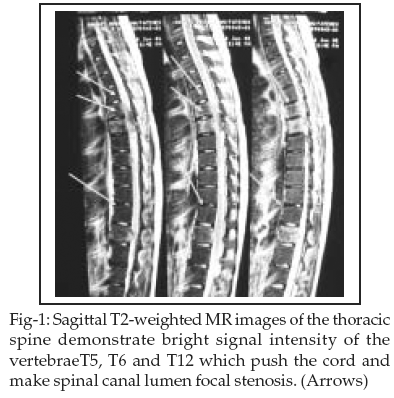
Case 2: A 25 years old man was referred to the hospital with back pain, paresthesia, urine frequency and impairment of gait. He was not able to walk without assistance. Total duration of the disease was 3 weeks. He had no history of thalassemia or blood transfusion. Past medical history included at the age of 9 years old and occasional folic acid supplementation consumption. In general appearance, he had facial expression of pain, seleral icterus, atrophy in lower extremities muscle. On physical examination, his blood pressure was 100/60mmHg, an apical 2/6 systolic murmur was heard, his neurological examination of the upper extremities was normal but in the lower extremities, muscle atrophy was seen. He had ankle clonus, exaggerated deep tendon reflexes, sensory deficit below T5 and T6. Lower muscles strength was 2/5.
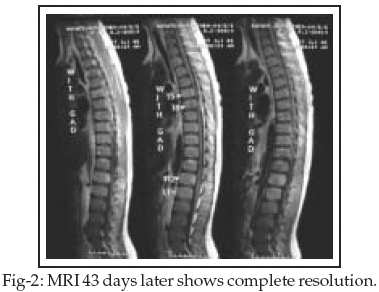
His hemoglobin concentration was 10.2g/dl , hematocrit: 32.7, reticulocyte count: 4%, mean corpuscular volume:80.5fl , mean corpuscular hemoglobin: 25.1pg, mean corpuscular hemoglobin concentration:31.2g/dl. Red blood cell count:4.06*1012 cell/liter total billirubin: 3.2mg/dl, direct billirubin:0.5mg/dl and serum ferritin was 1519ng/ml, Hemoglobin Electrophoresis on the alkaline media of cellulose acetate showed Hb A1:0% Hb F:98% Hb A2:2% ,uric acid 8.5 mg/dl,calcium:8.5ms/dl and phosphorous:5mg/dl. AST:74U/L, ALT:81 U/L NRBC:320/100WBC. Chest roentgenogram showed normal size of heart and multiple para vertebral masses due to EMH and coarsening of trabecular pattern of thoracic bone (Fig-3). MRI demonstrated soft tissue density from T2 to T10; causing narrowing of the cord canal (Fig-4).
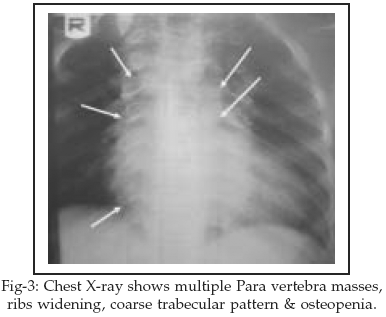
First case was successfully treated with low- dose radiotherapy and HU. Radiotherapy was started in 200cGY fractions to a total dose of 1600cGY and HU 10mg/kg/day. At the end of radiotherapy, the patient was ambulatory with mild residual weakness. She was regularly followed up for two years, at present she is active and asymptomatic. The second case was successfully treated with low-dose radiotherapy and HU. Radiotherapy was started in 200cGY fractions to a total dose of 1600cGY and HU 10mg/kg/day. At the end of radiotherapy the patient was ambulatory with mild residual weakness. Forty three days later MRI of the first case showed complete resolution (Fig-2).
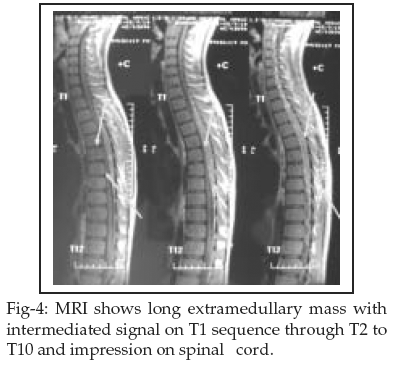
He was regularly followed up for 6 months. During his last visit, he was able to walk without a stick and he could climb stairs and his neurological examination was much better than before. One month later MRI of the second case showed some resolution and incomplete disappearance of soft tissue masses (Fig-5).
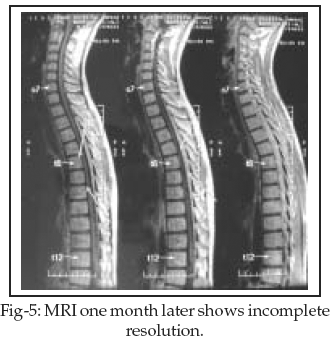
DISCUSSION
Spinal cord compression due to EMH is a well described but rare syndrome encountered in several clinical hematological disorders, including thalassemia ,sickle cell anemia, and
hereditary spherocytosis.7,9,10,13 It is rarely seen in Gaucher’s disease, Paget’s disease, alcohol- related macrocytosis and congenital dyserythyropoietic anemia.11,14-16 EMH is secondary to the production of blood cells outside the bone marrow and is a compensatory mechanism for bone marrow dysfunction.6 EMH is commonly seen at sites such as abdomen, chest, or epidural space.17,18 There are two forms of EMH namely "para-osseous"- in which the normal medullary tissue of the bone marrow ruptures through the bone to present as a para-osseous mass, and "extra-osseous"-in which EMH occurs within soft tissue. Para-osseous EMH occurs more frequently in hemoglobinopathies whereas extra-osseous EMH accompanies predominantly with the myeloproliferative disorders.19 Involvement of the epidural space by extramedullary hematopoiesis is most common in patients with thalassemia. It may occur by direct extension from the bone marrow, stimulation of embryonic multipotential hematopoietic stem cells, or via hematogenous emboli. Patients may present with complaints of back pain or spinal cord symptoms. Extramedullary hematopoiesis usually forms a soft, red mass resembling a hematoma on its cut surface. On histologic analysis, all hematopoietic elements are found in extramedullary hematopoiesis.20 Recognition of spinal cord EMH required prompt physical examination and MRI for accurate diagnosis.21 Documentation with an imaging technique, such as MRI is mandatory.22 Bone abnormalities are evident on plain radiographs. Expansion of the bone marrow is seen as osteoporosis with coarsened trabeculation. With severe involvement, there is expansion of the bony cortex. Spinal cord involvement may be suggested by the presence of paraosseous masses seen on chest radiographs. Along with the bone abnormalities, CT demonstrates extramedullary hematopoiesis as a soft-tissue mass that is often adjacent to the involved bone. Extramedullary hematopoiesis can be distinguished from the epidural fat because the former has attenuation similar to that of muscle and shows enhancement with intravenous administration of contrast material.23 MR imaging is the most effective method of demonstrating extramedullary hematopoiesis in the epidural space and is indicated on an urgent basis when symptoms of spinal cord compression are present. On T1-weighted images, extramedullary hematopoiesis is seen as an extramedullary mass with signal intensity slightly higher than that of the adjacent red marrow of the vertebrae. Similar findings are seen on T2-weighted images, with the signal intensity of extramedullary hematopoiesis being only slightly higher than that of bone marrow. Use of contrast material is unnecessary. T2-weighted sequences may be useful to demonstrate the high signal intensity of an injured spinal cord. This high signal intensity is from edema, myelomalacia, or gliosis of the spinal cord due to chronic compression.24 The most common site of spinal Epidural extramedullary hematopoiesis is posteriorly in the thoracic spine. Epidural space between the spinal dura mater and the ligaments and periosteum of the posterior spinal elements contains fat, loose connective tissue, and venous plexuses. It is widest in the posterior thoracic spine and is the most common site for extramedullary hematopoiesis when the spinal cord is affected.25 Management strategies have included radiotherapy, blood transfusion and, occasionally, surgery.26,27 Spontaneous recovery with no therapeutic intervention has also been reported but it may take several months to occur and is subject to frequent recurrence and morbidity.28 Although there is limited experience with HU in thalassemia, some studies have demonstrated successful regression of EMH with HU therapy.29-31 The EMH can be managed with radiation, surgery, transfusions, or a combination of these therapies. Radiation in conservative doses of (750-3500 cGy) is non-invasive, avoids surgical risks of potentially severe hemorrhage and incomplete resection and has a high complete remission rate in the majority of patients. Relapse rate moderate (37.5%), but retreatment provides excellent chance for second remission.20 EMH can be prevented by the institution of regular transfusion therapy which corrects anemia and thereby abolishes the stimulus for EMH. Surgical decompression is the method of choice for the management of the disease because histological diagnosis can be established and immediate decompression of the mass can be achieved. This is especially important in rapid decompression of spinal cord in patients with epidural mass caused by EMH.32 Disadvantages of surgical intervention include risk of excessive bleeding due to high vascularity of the mass and higher incidence of recurrence. Furthermore, total resection of the mass can lead to clinical decompensation and deterioration since these masses play a crucial role in maintaining an adequate hemoglobin level. To avoid this, incomplete resection of the mass should be attempted, followed by low dose radiation therapy. Being very sensitive to radiation therapy, low doses of radiation (1000-3000cGy), bring about a good clinical response. Major disadvantages of radiation therapy are lack of histological diagnosis and the reduction in the bone marrow activity secondary to the procedure itself. Hydroxyurea, a myelosuppressive agent, has also been successfully employed in the management of EMH.33 Differential diagnosis of posterior mediastinal location of EMH includes neurogenic tumours, lymphoma, paravertebral abscess and metastatic carcinoma. In geographic areas where thalassemia is prevalent, EMH should be considered in the differential diagnosis of patients who have chronic anemia with an intrathoracic mediastinal mass.ACKNOWLEDGMENT
Authors wish to thank patients and their families. This work was supported by Physiology and Thalassemia Research Center, Ahwaz Jondishapur University of Medical Sciences, Ahwaz, Iran.
REFERENCES
1. Haghshenas M, Zamari J. Thalassemia. 1st edition Shiraz University of Medical Sciences Publishing Center, Shiraz Iran 1997 (Book in Persian).
2. Modell B, Berdoukas V. The clinical approach to thalassemia, Grune & Stratton London:1984;244.
3. Piomelli S, Dsanoff S, Becker M, Lipera M, Travis S. Prevention of bone malformations and cardiomegaly in Cooley’s anemia by early hypertransfusion regimen. Ann NY Acad Sci 1969;165:427.
4. Propper RD, Button LN, Nathan DG. New approaches to the transfusion management of thalassemia. Blood 1980;55:55-9.
5. Weatherall DJ, Clegg JB.The thalassemia syndromes. 3rd ed. Oxford: Blackwell Sci Pub 1981.
6. Alam R, Padmanabhan K, Rao H. Paravertebral mass in a patient with thalassemia intermedia. Chest 1997;112:265-8.
7. Bolaman Z, Polatli M, Cildag O, Kadikoylu G, Culhaci N. Intrathoracic extramedullary hematopoiesis resembling posterior mediastinal tumor. Am J Med 2002;112:739-41.
8. Gumbs R, Ford EAH, Teal JS, Kletter GG, Castro O. Intrathoracic extramedullary hematopoiesis in sickle cell disease. Amer J Radiol 1987;149:889-93.
9. Chu KA, Lai RS, Lee CH, Lu JY, Chang HC, Chiang HT. Intrathoracic extramedullary hematopoiesis complicated by massive hemothorax in alpha-thalassemia. Thorax 1999;54:466-8.
10. Xiros N, Economopoulos T, Papageorgiou E, Mantzios G, Raptis S. Massive hemothorax due to intrathoracic extramedullary hematopoiesis in a patient with hereditary spherocytosis. Ann Hematol 2001;80:38-40.
11. Bowen EF, Marsh JC, Sandu C, Young M, Rayner CF. An elderly female with dyspnoea and anemia. Eur Respir J 2000;16:566-9.
12. Aliberti B, Patrikiou A, Terentiou A, Frangatou S, Papadimitriou A. Spinal cord compression due to extramedullary haematopoiesis in two patients with thalassaemia: complete regression with blood transfusion theraphy. J Neurol 2001;248:18-22.
13. Gumbs R, Ford EAH, Teal JS, Kletter GG, Castro O. Intrathoracic extramedullary hematopoiesis in sickle cell disease. Amer J Radiol 1987;149:889-93.
14. Chen IY, Lynch DA, Shroyer KR, Schwarz MI. Gaucher’s disease: An unusual cause of intrathoracic extramedullary hematopoiesis. Chest 1993;104:1923-24.
15. Relea A, Garcia-Urbon MV, Arboleya L, Zamora T. Extramedullary hematopoiesis related to Paget’s disease. Eur Radiol 1999;9:205-7.
16. De Geeter F, Van Renterghem D. Scintigraphic diagnosis of intrathoracic extramedullary hematopoiesis in alcohol-related macrocytosis. J Nucl Med 1996;37:473-5.
17. Chute DJ, Fowler DR. Fatal hemothorax due to rupture of an intrathoracic extramedullary hematopoietic nodule. Am J Forensic Med Pathol 2004;25:74-7.
18. Roder C, Dienemann H. Die extramedulläre blutbildung als differential diagnose der medias- tinalen raumforderung. Chirung 2000;71:1509-12.
19. Calhoun SK, Murphy RC, Shariati N, Jacir N, Bergman K. Extramedullary hematopoiesis in a child with hereditary spherocytosis: An uncommon cause of an adrenal mass. Pediatr Radiol 2001;31:879-81.
20. Munn RK, Kramer CA, Arnold SM. Spinal cord compressiondue to extramedullary hematopoiesis in beta-thalassemia intermedia. Int J Radiat Oncol Biol Phys 1998;1:42(3):607-9.
21. Lau SK, Chan CK, Chow YYN. Cord compression due to extramedullary hematopoiesis in a patient with thalassemia. Spine 1994;19:2467-70.
22. Coskun E, Keskin A. Spinal cord compression secondary to extramedullary hematopoiesis in thalassemia intermedia. Eur Spine J 1998;7(6):50-1-4.
23. Aydingoz U, Oto A, Cila A. Spinal cord compression due to epidural extramedullary hematopoiesis in thalassemia: MRI. Neuroradiology 1997;39:870-2.
24. Chaljub G, Guinto FC Jr, Crow WN, Kumar R. MRI diagnosis of spinal cord compression in beta-thalassemia. Spine 1991;16:583-4.
25. Pantongrag-Brown L, Suwanwela N. Chronic spinal cord compression from extramedullary hematopoiesis in thalassemia MRI findings. Clin Radiol 1992;46:281-3.
26. Gemenis T, Philipou A, Gouliamos A. Atypical location of extramedullary hematopoietic masses in thalassemia. Radiology 1989;29:295-6.
27. Ahmed F, Tobin MS, Cohen DF. Beta thalassemia spinal cord compression. NYSJ Med 1981;81:1.505-8.
28. Kaufmann T, Colecman M, Giardina P, Nisce LZ. The role of radiation therapy in the management of hematopoietic neurologic complications in Thalassemia. Acta Haematol 1991;85:156-9.
29. Konstantopoulos K, Vaggiopoulos G, Kantouni R. A case of spinal cord compression by extramedullary haematopoiesis in a thalassemic patient: a putative role for hydroxyurea? Haematologica 1992;77:352-4.
30. Cianciulli P, Caravita di Toritto T, Sorrentino F. Hydroxyurea therapy in paraparesis and cauda eqina syndrome due to extramedullary haematopoiesis in thalassemia: Improvement of clinical and haematological parameters. Eur J Haematol 2000;64:426-9.
31. Saxon BR, Rees D, Olivieri NF. Regression of extramedullary haemopoiesis and augmentation of fetal haemoglobin concentration during hydroxyurea therapy in thalassemia. Br J Haematol 1998;101:416-9.
32. Ameri AA, Bagheri MH, Jalal SJ, Habibzadeh F. Spinal cord compression secondary to extramedullary hematopoiesis in thalassemia. Iran J Radiol 2003;1:7-11.
33. Cario H, Wegener M, Debatin KM, Kohne E. Treatment with hydroxyurea in thalassemia intermedia with paravertebral pseudotumors of extramedullary hematopoiesis. Ann Hematol 2002;81:478-82.
HOME | SEARCH | CURRENT ISSUE | PAST ISSUES
Professional
Medical Publications
Room No. 522, 5th Floor, Panorama Centre
Building No. 2, P.O. Box 8766, Saddar, Karachi - Pakistan.
Phones : 5688791, 5689285 Fax : 5689860
pjms@pjms.com.pk